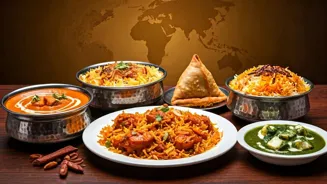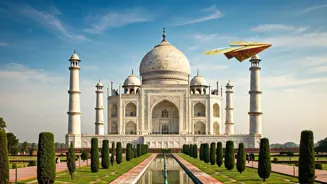Explore the fascinating journey of Indian cuisine, from ancient trade routes to modern fusion dishes. Discover how Indian flavors have shaped global culinary experiences. Delve into the historical roots
and cultural impact of Indian food on the world's plate
For centuries, Indian food has travelled far beyond its own borders, leaving a delicious mark on global cuisine. It's not just about spicy curries, but a long history of exchange, adaptation, and innovation.

From ancient trade routes to modern-day restaurants, the story of Indian food is a mirror reflecting the country's interactions with the world.
It's a testament to the versatility of Indian ingredients and the creativity of cooks who have adapted their recipes to local tastes and available resources. The aroma of cardamom or the zing of ginger, once exotic imports, are now commonplace in kitchens across the globe.
Ancient spice trade shaped Indian cuisine with global influences
The story begins in ancient times, with the bustling trade routes that crisscrossed the Indian subcontinent. Spices like pepper, cinnamon, and cardamom were highly valued commodities, sought after by merchants from Europe, the Middle East, and Southeast Asia.
These spices not only enhanced the flavor of food but also played a role in preserving it. The exchange wasn't one-way. India also received new ingredients from other parts of the world.
Chillies, tomatoes, and potatoes, now integral to Indian cooking, were introduced by the Portuguese in the 16th century. These new ingredients were quickly adopted and adapted, adding new dimensions to already flavorful dishes.
Mughal era enriched Indian cuisine with Persian influence
The Mughal era (16th-19th centuries) brought significant changes to Indian cuisine. The Mughals, emperors with Persian and Central Asian roots, introduced elaborate dishes and sophisticated cooking techniques.
Dishes like biryani (a spiced rice dish with vegetables) and rich curries with dried fruits became integral to Indian culinary heritage. These dishes combined Indian spices with Persian flavors, creating a unique fusion that remains popular even today.
Mughal cuisine not only influenced royal kitchens but also filtered down to the common people, enriching the diversity of Indian food.
British colonialism shaped Indian cuisine, creating Anglo-Indian dishes
The British colonial period (18th-20th centuries) had a profound impact on Indian food, both in India and abroad. While some British administrators appreciated Indian cuisine, others sought to simplify and adapt it to their palates.
This led to the creation of dishes like "kedgeree" (a rice and lentil dish) and "mulligatawny soup" (a spiced lentil soup). These Anglo-Indian dishes were then introduced to Britain and other parts of the British Empire.
At the same time, Indian immigrants brought their culinary traditions to new lands, establishing restaurants and sharing their foods.
Post-Independence Indian food evolves globally, fusion & innovation
Following India's independence in 1947, new changes occurred within Indian food. The global diaspora grew significantly. Indian communities established themselves in the UK, the US, Canada, and many other countries.
They opened restaurants and grocery stores, making Indian ingredients available to a wider audience. Chefs began to experiment with fusion cuisine, blending Indian flavors with Western cooking techniques.
Today, Indian food continues to evolve, adapting to local tastes and embracing innovation while retaining its core essence. It's now common to find international variations of common indian food items available abroad.
Indian food's global journey: cultural exchange, adaptation, innovation, evolving flavors
Today, Indian food enjoys global popularity. From humble street food stalls to high-end restaurants, Indian flavours have spread everywhere. Dishes like samosas, biryani, and curries are recognized and enjoyed by people all around the world.
The story of Indian food in the global context is a story of cultural exchange, adaptation, and innovation. As Indian food continues to adapt, it serves as a powerful reminder of the interconnectedness of cultures and the importance of food as a bridge between people.
It is continuously evolving with modern techniques.
AI Generated Content. Glance/InMobi shall have no liability for the content










